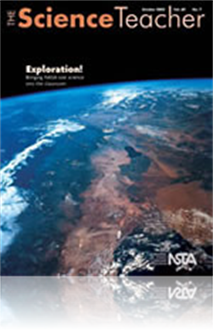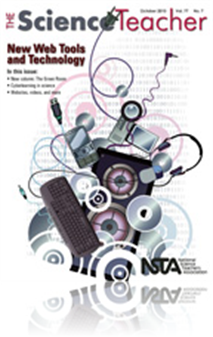All The Science Teacher resources
Journal Article
The Idea Bank provides tips and techniques for creative teaching, in about 1,000 words. In this month’s Idea Bank learn about other potential uses for slime, in addition to polymer chemistry and materials engineering....
Journal Article
Student Teaching Tools: Key factors to remember in the classroom
Upon starting the actual process of teaching you can never be completely prepared for the experience. This author identifies four key factors that will help you through student teaching: organization, confidence, balance, and patience. Ideas on how t...
Journal Article
Probing for Understanding: Measuring scientific achievement with assessment probes
Measuring whether students have a deep understanding of scientific concepts is a challenge for educators. Using assessment probes allows inquiry into the meaning of deep understanding. The author shares several probes designed to research and gather ...
Journal Article
Commentary: Supporting the Student Teacher
An opinion piece about how the cooperating teacher continues to be the major influence on the student teacher. ...
Journal Article
Editor's Corner: Training Grounds for the Future
Training student teachers is a critical skill. The Science Teacher’s editor shares thoughts on student teaching....
Journal Article
Commentary: Why We Accept the Challenge
An opinion piece about qualified teachers serving as mentors to pre-service science teachers....
Journal Article
Seeing Isn't Always Believing: Investigating the reliability of classroom demonstrations
The author describes a traditional classroom experiment often used to demonstrate the amount of oxygen in the atmosphere, and challenges the high school chemistry students to test the validity of the procedure. Together they developed a way to deter...
Journal Article
Exploration Science: A case history from Earth orbit
The intent of this case history is to encourage science fair organizers to permit students to submit observational science projects, not just experimental ones. The author shares a condensed example of his own research to illustrate the interplay of ...
Journal Article
Excavating Cratering: Bringing a NASA mission into Earth science classrooms
The author brings NASA research on excavating a crater into the science classroom in the form of an inquiry investigation. Students begin to see that science, even NASA mission-size science, is something they can do. Lesson plans, student examples, a...
Journal Article
New teachers often are given the most preparations, classroom moves, and demanding students. In addition, new teachers are sometimes added to the roster at the last minute and never have a chance to tour the school and connect with colleagues. Bewild...
Journal Article
One way to improve teacher retention is to adequately prepare preservice teachers while they are enrolled in professional teacher education programs at colleges and universities. In a model developed at Towson University, preservice science teachers ...
Journal Article
Editor's Corner: Create a Sense of Belonging
The Science Teacher’s editor shares thoughts on the mentoring of new teachers....
Journal Article
Isolation, both physical and social, is not new to teaching (Lortie, 1975). The structure of the school building itself isolates teachers from one another (Harris, 1995). This coupled with invisible walls constructed by the culture of teaching, creat...
Journal Article
Commentary: Partnerships—Promoting Excellence and Equity in Science
An opinion piece about how to succeed in promoting excellence and equity in science. We must work with other organizations and agencies to provide high-quality professional development experiences for all science teachers and increase support for sci...





